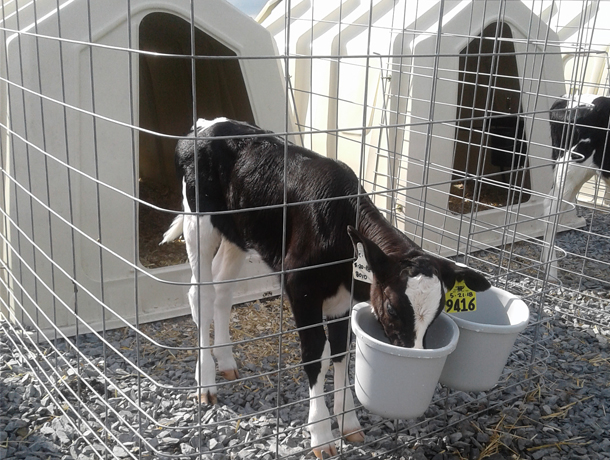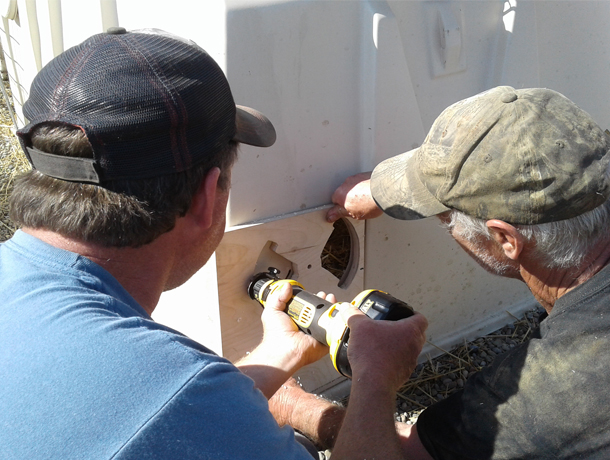Here’s a question for you…did you water ALL your calves this morning?

We are in the midst of the summer heat and it’s important to assure that calves have plenty of water to drink. Calves that are less than two weeks old may choose to drink only a few sips of water, while older calves will drink double their normal intake when temperatures are in the upper 80s or higher and the water is available.
I see it too often, it’s hot and the calves less than two weeks old don’t have any water in front of them. The most common explanation is that they are small and get their water from the milk or milk replacer they are consuming. But, the calf’s suckling reflex is stimulating that milk to be sent through the esophageal groove to the abomasum, which leaves the rumen in need of water for its development.
When calves are drinking water, it goes to the rumen where it mixes with calf grain to stimulate the development of the rumen lining. According to Sam Leadley’s Calving Ease newsletter, “Water: The Magic Growth Promoter,” USDA surveys report on average U.S. dairies begin to feed water to newborn calves at 17 days of age.
Are we maximizing growth rates with that practice? The short answer is no. Research shows that when water is offered beginning at Day 1, there are measurable differences in body weight at 5 months of age and hip height and body length at 10 weeks, as compared to waiting until Day 17 (Wickramasinghe).
On the flip side of newborns, it is also important to deliver extra water to calves as the amount of milk is being decreased leading up to weaning. Their water consumption will double in this time period and I often see water delivered fresh to calves in individual hutches or pens at least twice daily to keep encouraging intakes.
Besides water, what can be done to help calves through these hot temperatures?
- Keep the air moving by situating calf housing to capitalize on prevailing wind direction. Turning hutches to face east and opening all vents in the summer can help. You might also consider installing additional back vents on older hutches to help assure fresh air at the calf’s nose level when resting.

- Indoor calf facilities may benefit from additional fans, especially between 8 a.m. and 5 p.m. Research has shown average daily gains improved by 23% for calves cooled by fans (Hill et al). Calf-Tel pens now come with a variety of side and back options to allow extra ventilation for calves housed indoor.
- Keep water pails clean. This is even more important in hot weather and calf managers use a variety of schedules for this, ranging from daily, weekly or bi-weekly depending on the labor available. One way that I see commonly is that a set portion of the pails are cleaned on certain days each week. This is also an easier task if there is an easy way to transport both the pails and clean water to and from the calf housing area.
- Keep the calf starter grain fresh to encourage consumption.
- Some producers are finding that bedding with sand works well in the warmer months. As with all other bedding material, it should be clean and dry.
- Try to organize the day so that any vaccinations, pen moves or transportation or other stressors to calves happen in the morning when temperatures are still moderate.
- Don’t forget to keep yourself hydrated in the summer heat. After all, it is Drink-Your-Water-Wednesday! And that applies to everyone.
References:
- Jones, C. and Heinrichs, J. (2013, June 14). Heat stress in dairy calves. Penn State Extension. Retrieved from https://extension.psu.edu/heat-stress-in-dairy-cal….
- Leadley, S. (2019, July). Water: the magic growth promoter. Calving Ease. Retrieved from http://atticacows.com/library/newsletters/CEJuly20….
- Wickramasinghe, H.K.J.P., et al. (2019). Drinking water intake of newborn dairy calves and its effects on feed intake, growth performance, health status, and nutrient digestibility. Journal of Dairy Science, 102: 377-387.
- Kelly Driver has been involved in the New York dairy industry all her life. In addition to raising dairy calves and replacement heifers, she is the Northeast Territory Manager for Calf-Tel. Feel free to contact her at kellydriver@hampelcorp.com with your calf questions or suggest a topic you would like covered in a future blog.
Courtesy of our dealer – CRI REPRODUCCIÓN ANIMAL MÉXICO SA DE CV.
